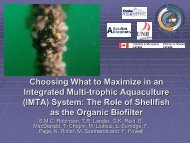Integrated multi-trophic aquaculture (IMTA) in marine temperate waters
Integrated multi-trophic aquaculture (IMTA) in marine temperate waters
Integrated multi-trophic aquaculture (IMTA) in marine temperate waters
Create successful ePaper yourself
Turn your PDF publications into a flip-book with our unique Google optimized e-Paper software.
<strong>Integrated</strong> <strong>multi</strong>-<strong>trophic</strong> <strong>aquaculture</strong> (<strong>IMTA</strong>) <strong>in</strong> mar<strong>in</strong>e <strong>temperate</strong> <strong>waters</strong> 13<br />
salmonids and other carnivorous mar<strong>in</strong>e fish and shrimp, which, <strong>in</strong> fact, represent only<br />
10.7 percent of the world mariculture production (but 40.8 percent of its value).<br />
From the above numbers for mariculture, one may be <strong>in</strong>cl<strong>in</strong>ed to th<strong>in</strong>k that at the<br />
world level, the two types of <strong>aquaculture</strong>, fed and extractive, are relatively balanced.<br />
However, because of the predom<strong>in</strong>antly monoculture approach, these different types<br />
of <strong>aquaculture</strong> production are often geographically separate, and, consequently,<br />
rarely balance each other out on the local or regional scale. For example, <strong>in</strong> Eastern<br />
Canada, fed salmon <strong>aquaculture</strong> is primarily located <strong>in</strong> the Bay of Fundy <strong>in</strong> Southern<br />
New Brunswick and <strong>in</strong> Southern Newfoundland, while extractive mussel and oyster<br />
<strong>aquaculture</strong> is located <strong>in</strong> the Northumberland Strait and the Lower Gulf of St. Lawrence,<br />
along the coastl<strong>in</strong>es of Pr<strong>in</strong>ce Edward Island and Northeastern New Brunswick, and<br />
<strong>in</strong> Eastern Nova Scotia and Northeastern Newfoundland. In Japan, <strong>aquaculture</strong> is<br />
mostly carried out with various bays dedicated to either shellfish, seaweed or f<strong>in</strong>fish<br />
<strong>aquaculture</strong>. There are, however, examples <strong>in</strong> Ch<strong>in</strong>a of bays managed accord<strong>in</strong>g to the<br />
<strong>IMTA</strong> approach (Chop<strong>in</strong> and Sawhney, 2009).<br />
While <strong>IMTA</strong> may seem like a new concept to western farmers, this approach to<br />
farm<strong>in</strong>g and <strong>aquaculture</strong> has long been <strong>in</strong> use <strong>in</strong> Asian countries. Japan and Ch<strong>in</strong>a have<br />
used this technique for the co-culture of rice and fish for millennia (Neori et al., 2004).<br />
Even if the cultured species are different, why, then, is this common-sense solution<br />
not more widely implemented, especially <strong>in</strong> the western world? The reasons for this<br />
generally center around social customs and practices that we are already familiar with,<br />
even if common sense tells us that we should modify them. Human society does not<br />
change quickly unless there are compell<strong>in</strong>g reasons to. The conservative nature of our<br />
mar<strong>in</strong>e food production <strong>in</strong>dustries is a good example of the relative slowness with which<br />
changes are adopted, especially when deal<strong>in</strong>g with a complex aquatic environment,<br />
which we mostly see only the surface of, and have difficulty understand<strong>in</strong>g the<br />
processes tak<strong>in</strong>g place beneath it over considerable distances and volumes.<br />
Western countries are regularly re<strong>in</strong>vent<strong>in</strong>g the wheel. Research on <strong>in</strong>tegrated<br />
methods for treat<strong>in</strong>g wastes from modern mariculture systems was <strong>in</strong>itiated <strong>in</strong> the 1970s<br />
(Ryther, DeBoer and Lapo<strong>in</strong>te, 1978). After that period, the scientific <strong>in</strong>terest <strong>in</strong> <strong>IMTA</strong><br />
stagnated, and it was not until the late 1980s and early 1990s (Indergaard and Jensen,<br />
1983; Buschmann, López and Med<strong>in</strong>a, 1996; Kautsky, Troell and Folke, 1996; Chop<strong>in</strong><br />
et al., 1999) that a renewed <strong>in</strong>terest emerged, based on the common-sense approach that<br />
the solution to nitrification is not dilution but conversion with<strong>in</strong> an ecosystem-based<br />
management perspective. This <strong>in</strong>terest has likely been an <strong>in</strong>direct result of the <strong>in</strong>creased<br />
demand for <strong>aquaculture</strong> products. In 2004, <strong>aquaculture</strong> production from mariculture<br />
was 30.2 million tonnes, represent<strong>in</strong>g 50.9 percent of the global <strong>aquaculture</strong> (FAO,<br />
2006a), which has steadily <strong>in</strong>creased each year s<strong>in</strong>ce the 1950s, at a rate of roughly 10<br />
percent (FAO, 2006a). This <strong>in</strong>crease has <strong>in</strong> turn, resulted <strong>in</strong> <strong>in</strong>tensified cultures, decrease<br />
<strong>in</strong> available habitat (space available for cage sites/<strong>aquaculture</strong> leases), and <strong>in</strong>creased<br />
environmental impacts on the immediate ecosystem. <strong>IMTA</strong> is a method whereby<br />
production can be <strong>in</strong>tensified, diversified and yet rema<strong>in</strong> environmentally responsible –<br />
thereby ensur<strong>in</strong>g a susta<strong>in</strong>able <strong>aquaculture</strong> <strong>in</strong>dustry. Multi-<strong>trophic</strong> <strong>in</strong>tegration appears<br />
to be a logical next step <strong>in</strong> the evolution of <strong>aquaculture</strong>.<br />
This trend <strong>in</strong> the global recognition of the need for more advanced ecosystembased<br />
<strong>aquaculture</strong> systems has begun to show up <strong>in</strong> the scientific world through the<br />
<strong>aquaculture</strong> conference circuit. For example, <strong>in</strong> recognition of this grow<strong>in</strong>g <strong>in</strong>terest,<br />
the Aquaculture Europe 2003 Conference <strong>in</strong> Trondheim, Norway, whose theme was<br />
“Beyond Monoculture”, was the first large <strong>in</strong>ternational meet<strong>in</strong>g (389 participants<br />
from 41 countries) with <strong>IMTA</strong> as the ma<strong>in</strong> topic. In 2006, at the jo<strong>in</strong>t European<br />
Aquaculture Society and World Aquaculture Society Conference <strong>in</strong> Florence, Italy,<br />
<strong>IMTA</strong> was recognized as a serious research priority and option to consider for the<br />
future development of <strong>aquaculture</strong> practices.



